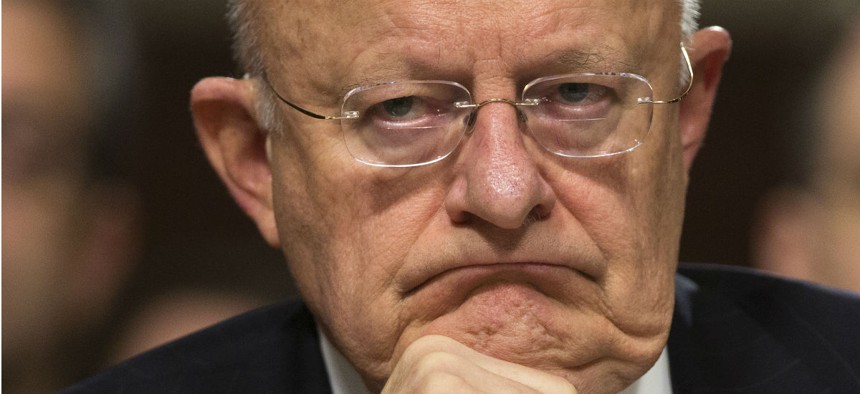
Director of National Intelligence James Clapper has asked intelligence agencies to bring him ideas on improving recruitment. Evan Vucci/AP
In a First, Intel Community Publishes Its Diversity Numbers
Progress is shown in minority advancement, but percentages still trail other agencies.
The 17 agencies that form the Intelligence Community are under orders to improve hiring and promotion of women and minorities, an effort that is showing noteworthy but insufficient progress, according to the first publicly released report on intelligence workforce demographics.
“It is through leveraging diverse perspectives that we draw strength, increase engagement, unleash creativity and solve difficult challenges inherent to the IC’s mission,” said Director of National Intelligence James Clapper on Friday in releasing for the first time a mandatory report that has been delivered only to Congress for a decade. Publishing the numbers is “the latest in a series of steps shedding light on the IC’s struggle to recruit talented officers who mirror the diverse country they serve,” a statement said.
The percentage of minorities in the IC rose from nearly 21 percent in fiscal 2011 to about 25 percent in fiscal 2015, the report said. Yet the community’s minority makeup remains lower than that of the rest of the federal workforce, which is 35 percent. Also, only 12 percent of IC workers at the senior pay levels were minorities, as of Sept. 30, 2015.
“While we have made progress, the data indicates greater work needs to be done to create a more diverse workforce,” said Rita Sampson, chief of the Office of the Director of National Intelligence’s Equal Employment Opportunity & Diversity unit.
Overall minority representation in hiring at intelligence agencies increased from 23.6 percent in fiscal 2014 to 24.9 percent in fiscal 2015, mostly through a boost in Hispanic recruits. But minorities are represented at less than expected frequencies with regard to promotions, awards, Selected Educational Development Programs and joint duty assignments, the study showed.
The proportion of women in the IC remained just below 40 percent over the past five years, though the attrition rate among female employees dropped slightly over the past year. In 2015, women earned 43.9 percent of promotions and 46.8 percent of honorary awards, a rate above their representation in the workforce (38.5 percent), the report said.
The representation of persons with disabilities rose by slightly more than one half of one percentage point between 2014 and 2015, the report said, and would have been higher had the attrition rate (6.9 percent) not been greater than average among people with disabilities.
Clapper has tasked the agencies to bring him “actionable ideas” to improve recruitment. Many agencies have added training such as “unconscious bias workshops,” the report said, and have instituted whistleblower protections to boost hiring and promotion of minority and female employees.







